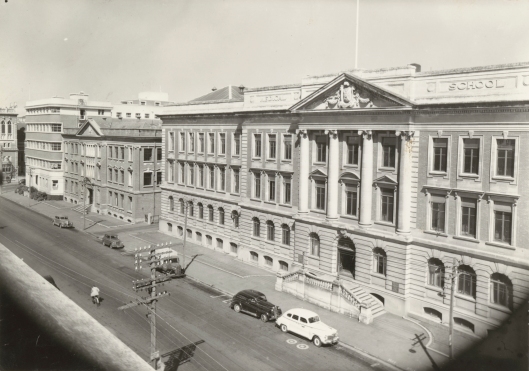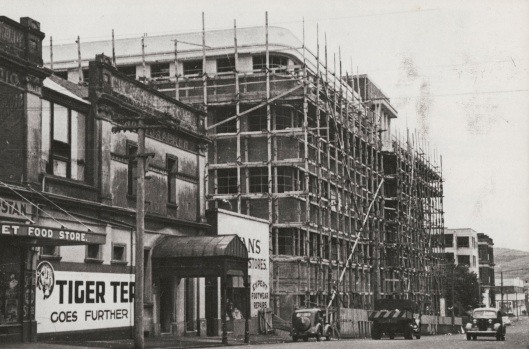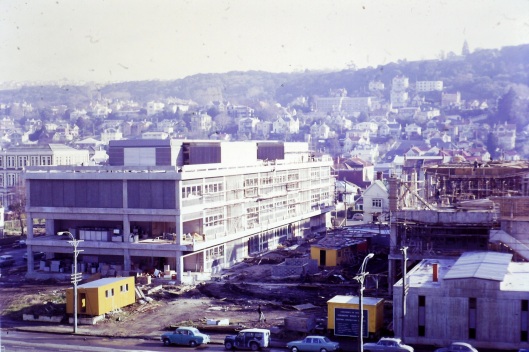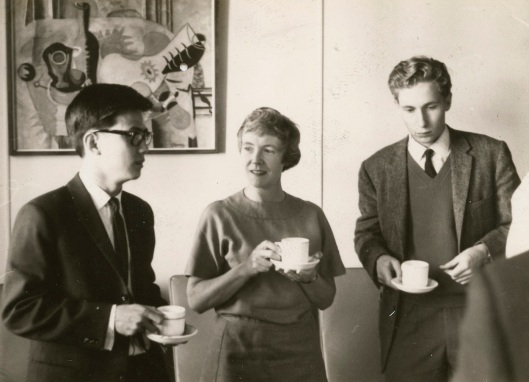Tags
1910s, 1920s, 1940s, 1950s, 1960s, 1970s, anatomy, biochemistry, library, medicine, microbiology, obstetrics and gynaecology, pharmacology, pharmacy, physiology, preventive and social medicine, surgery

An aerial view showing the medical school and hospital buildings, c.1970. The low-rise 1950s building replaced by the Sayers building can be seen between the Wellcome and Ferguson buildings, with cars parked in front. At the hospital, the clinical services building, opened in 1968, can be seen, but construction is yet to begin on the ward block, which opened in 1980. Several of the buildings in the block east of the hospital are now part of the university: the original Queen Mary maternity hospital now houses the surveying school and marine science department; the 2nd Queen Mary hospital is Hayward College, and the old nurses’ homes are Cumberland College. Image courtesy of the Hocken Collections, University of Otago Medical School Alumnus Association records, MS-1537/806, S17-517b.
There’s a significant university anniversary this year: it’s a century since the medical school opened its first Great King Street building. Otago medical classes started out in the university’s original building in Princes Street, but soon moved to the purpose-built anatomy and chemistry block (now the geology building) on the new site near the Leith. Opened in 1878, the new premises incorporated a lecture room, dissection room, preparation room, morgue, laboratory, anatomy room and professor’s office for the medical school. The facilities weren’t large – they were designed to cater for classes of a dozen or so – and the building was extended in 1883 and again in 1905, to provide for the expanding school and its first physiology professor. As medical student numbers continued to expand, from 80 in 1905 to 155 in 1914, space became desperately short and the medical faculty won government approval for further extensions to the anatomy and physiology departments, plus a new building to house the pathology and bacteriology (microbiology) departments, along with other subjects being taught in far from ideal conditions in the crowded hospital.
The site of the new building – in Great King Street, opposite the hospital – was controversial. Some university council members wanted all new developments to be on the existing campus, but medical academics wanted to be closer to the hospital, and the chancellor, Andrew Cameron, was on their side. Sydney Champtaloup, professor of public health and bacteriology, revealed the thinking behind the move during the 1914 public appeal for funds for the new building. After completing their studies in anatomy and physiology, which would still be taught at the university, said Champtaloup, ‘students are intimately associated with the Hospital. At present students attend some classes at the University, and have then to proceed to the Hospital for others, and to return to the University later. This involves a great waste of time and energy. All lectures and practical classes for senior students should be held in a suitable building near the Hospital’. He also pointed out that the hospital and university both required bacteriology and pathology labs, and ‘a combination of these requirements in one building makes for efficiency and economy, but that building to meet Hospital requirements must be either in the Hospital grounds or in its close proximity’. Although he didn’t mention it, Champtaloup would have to waste considerable time and energy himself if the new building wasn’t close to the hospital, since he was in charge of its bacteriology services.

The bacteriology and pathology building, later known as the Scott building, which opened in 1917. Image courtesy of the Hocken Collections, University of Otago Medical School Alumnus Assocation records, MS-1537/636, S17-517a.
The public appeal raised the goodly sum of £8000 (over $1 million in 2017 values), which included £2000 from William Dawson (a brewer who made a fortune as one of the founders of Speight’s) and £1000 from members of the medical faculty. It was matched by the government, though the project ran considerably over budget thanks to ‘the presence of subterranean water, later found to characterise the whole area’, along with rising prices due to war conditions. The new building, designed by Mason and Wales and built by Fletcher Brothers, opened in 1917. Of brick with Oamaru stone facings, its neoclassical style seemed quite plain to contemporaries; the Evening Star noted some ‘pretty stained glass’ in the entrance hall was ‘one of the few ornamentations’. The building was large and well-lit, with a lecture theatre able to ‘seat 150 students and give everyone plenty of elbow room’ and other smaller lecture rooms; they incorporated facilities for the latest technology, the lantern slide. The pathology department was on the first floor and the bacteriology department on the second floor; there were also rooms dedicated to medical jurisprudence and materia medica (pharmacology), the library, specimen museum and an assortment of staff and student facilities. ‘The roof is used for store rooms, etc.’, reported the Star with some delicacy; that was where animals and food stores were housed.
The new building was just the beginning. Medical dean Lindo Ferguson had ambitious plans; he imagined the school expanding to take up the entire side of the Great King Street block facing the hospital, replacing its collection of old cottages and shops. Not everybody approved, and there was another battle over the new anatomy and physiology building. In 1919 university council members decided that further extensions to those departments should be on the main university campus, provoking a determined – and successful – campaign by the medical faculty, medical association and ODT to have them change their minds and instead construct a large new building adjoining the 1917 one. Physiology professor John Malcolm countered one of the main objections to the Great King Street site: ‘It had been said that the social life of the university was cut in two through the existing arrangements; and if that were so how about the scientific life of the university? Was it not cut in two as well? The most important was the human life’. After considerable delays in raising funds, in 1927 a splendid new building – ‘one of Dunedin’s most handsome’, declared the ODT – was opened. Designed by Edmund Anscombe in brick and stone facings to complement its neighbour, it provided accommodation for not just anatomy and physiology, but also the ‘sub-departments’ of histology, biochemistry and pharmacology. It had the ‘necessary classrooms, laboratories, and research rooms for a school averaging an annual class of 50 students’.
At the opening of the new block, Ferguson joked that ‘if a dean were content he was not fit to hold his position. No one knew the shortcomings of a school better than the dean, and if the dean thought that enough had been done he should be pole-axed’. He continued to dream of further expansion, and had already foiled suggestions the new dental school building should be immediately next to the medical school; instead its new 1926 building (now the Marples building) was constructed on the next block. Ferguson’s successors took up his scheme and in the midst of World War II work began on yet another large building. It had the prosaic name of ‘the south block’, but later the various buildings were named after the medical deans, according to their chronology, and it became the Hercus building, after third dean Charles Hercus; the earlier buildings were named for the first two deans, John Halliday Scott and Lindo Ferguson.

The Ferguson building (opened 1927), with the Scott building (1917) and Hercus building (1948) in the distance. Image courtesy of the Hocken Collections, University of Otago Medical School Alumnus Association records, MS-1537/637, S17-517c.
The south block was in brick and of similar scale to its neighbours, but the similarities ended there; it was a striking example of art deco, designed by Miller White and Dunn. Hercus recounted how the Minister of Education, Rex Mason, ‘turned down our original severely utilitarian plan with the statement, “This is not a factory, but a national building of great importance, and it must bear the marks of its function”’. The new design incorporated various artworks, most notably a sculptured marble panel by Richard Gross above the main Hanover Street entrance; there were also plaster murals inside. Building was a challenge because of wartime labour and supply shortages; four Dunedin building firms – Love, Naylor, Mitchells and McLellans – formed the Associated Builders consortium to complete the project. Some students obtained holiday work helping with the demolition and ground works for the foundations, which were dug down 15 metres, but the foreman ‘had to keep his eye on them because many would jump the fence and be off’. The building opened in 1948 and boasted 210 rooms; it became a new home for the preventive medicine, pathology and bacteriology departments and had two dedicated research floors, one of them for animals.

The new south block (Hercus building) under construction in the 1940s, looking east along Hanover Street. Image courtesy of the Hocken Collections, University of Otago Medical School Alumnus Association, MS-1537/631, S15-619f.
The next building development was less imposing and not destined to last for long: a single-storey brick building, completed in 1956 next to the Ferguson building, provided a space for the surgery and obstetrics and gynaecology departments. Next to it, on the corner of Frederick and Great King Streets, appeared in 1963 the Wellcome Research Institute. Funded entirely by the Wellcome Trust, which was created from a pharmaceutical fortune, the new building was a tribute to the important research on hypertension by Otago medical professor Horace Smirk, and provided a space for various research teams. It soon developed the nickname ‘Hori’s whare’, while the dental school was ‘Jack’s shack’ after dental dean John Walsh and the pharmacology department in the old Knox Sunday school was ‘Fred’s shed’ after its professor, Fred Fastier. The Wellcome building was designed by Niel Wales, the latest generation in old Dunedin firm Mason and Wales, which had also been responsible for the Scott building; the new building’s international style, with its simple forms and lack of ornamentation, reflected the architectural fashion of the period.
The next buildings took the medical campus further into the realms of new architecture. In 1972 the medical library acquired a new home in the Sayers building, named for the fourth dean, Ted Sayers. The building, which replaced the 1950s surgery and O & G construction, also included accommodation for the medical school administration. A year later the multi-storey Adams building (Bill Adams was the fifth dean) emerged behind it, with an entrance from Frederick Street; it provided new space for the preventive and social medicine, pharmacology, pharmacy and surgery departments, along with the university’s higher education development centre. The Sayers building was designed by Alan Neil of Fraser Oakley Pinfold. A 1994 exhibition on University of Otago architecture suggested his ‘use of fair-faced concrete is an essay in Brutalism’. The Adams building was designed by Miller White and Dunn and the design was recycled in the microbiology building, opened in 1974 on Cumberland Street. The 1994 exhibition noted its utilitarian architecture: it ‘appears to have been designed from the inside out’ and ‘no thought appears to have been given to the external appearance .… Built in the tradition of tower blocks in a park-way, it does not invite inspection of detailing’.

The new Sayers (front) and Adams buildings in the 1970s. Image courtesy of the Hocken Collections, University of Otago Medical School Alumnus Association records, MS-1537/665, S17-517d.
With the 1970s buildings completed, Lindo Ferguson’s 1910s vision of a medical school encompassing the length of the block was fulfilled. Indeed, the school was already spreading much further afield, with microbiology and biochemistry buildings on the new science campus in Cumberland Street and new developments in Christchurch and Wellington. At its Great King Street home base, the school was a showcase of 20th century architecture, from neoclassicism and art deco to international style and brutalism. Across the street, Dunedin Hospital, whose presence had drawn the medical school to this location, also went through multiple developments. That, however, is a whole other story.














